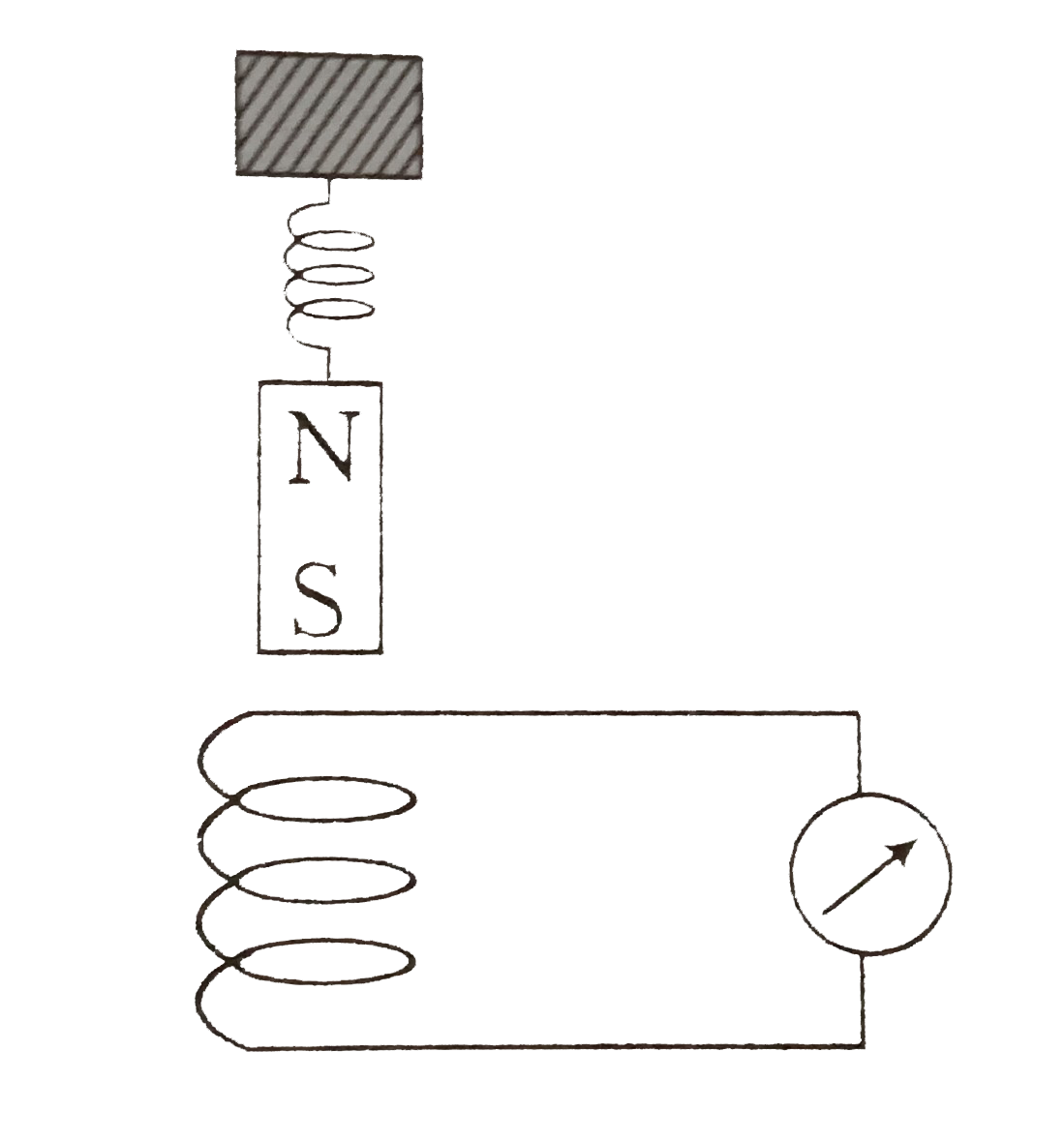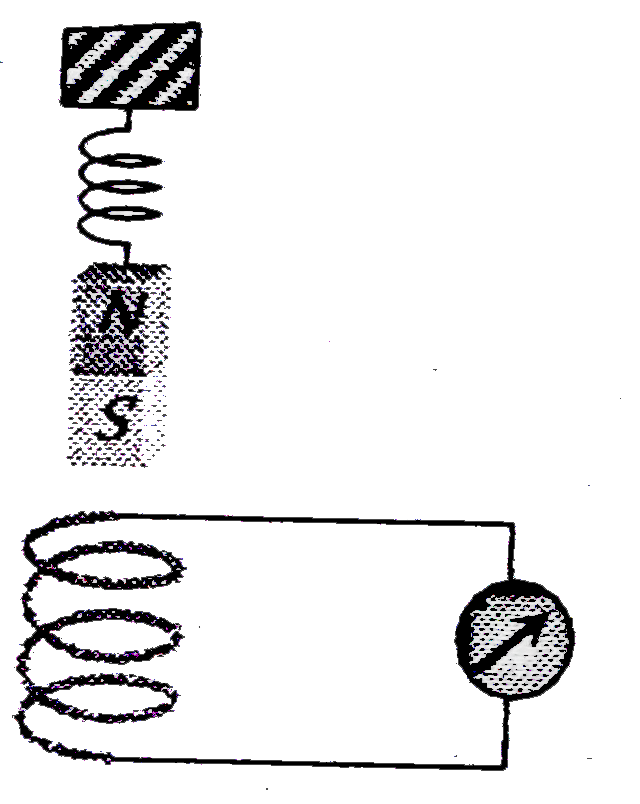A magnet N-S is suspened from a spring and when it oscillates, the magnet moves in and out of the ocil C. the coil is connected to a galvanometer G. then, as the magnetic oscillates
G shows no deflection
G shows deflection to the left and right but the amplitude steadily decreases
G shows deflection to the left and right with constant amplitude
G shows deflection on one side
The correct Answer is:B
To solve the problem, let's break it down step by step:
Step 1: Understand the Setup
A magnet (with North and South poles) is suspended from a spring and oscillates. As it moves in and out of a coil (C) connected to a galvanometer (G), we need to analyze the effects of this motion.
Hint: Visualize the arrangement: the magnet oscillates vertically while the coil is stationary.
Step 2: Identify the Motion of the Magnet
The magnet will perform simple harmonic motion (SHM) due to the restoring force provided by the spring. The oscillation can be described by the equation of motion for SHM, where the acceleration is proportional to the negative of the displacement.
Hint: Remember that SHM is characterized by a restoring force that is proportional to the displacement from the equilibrium position.
Step 3: Analyze the Magnetic Flux Change
As the magnet oscillates, it moves in and out of the coil. This movement changes the magnetic flux (Φ) through the coil. According to Faraday's law of electromagnetic induction, an electromotive force (emf) is induced in the coil due to this change in magnetic flux.
Hint: Recall that the induced emf (ε) is given by the negative rate of change of magnetic flux: ε = -dΦ/dt.
Step 4: Determine the Direction of Induced Current
Using Lenz's Law, the direction of the induced current will be such that it opposes the change in magnetic flux. When the magnet moves downwards, the magnetic flux through the coil increases, and the induced current will flow in a direction that creates a magnetic field opposing this increase.
Hint: Use the right-hand rule to determine the direction of the induced current based on the direction of the magnetic field and the motion of the magnet.
Step 5: Analyze the Galvanometer's Response
The galvanometer (G) will show a deflection due to the induced current. When the magnet moves down, the galvanometer will deflect in one direction (say left), and when the magnet moves up, it will deflect in the opposite direction (say right).
Hint: The deflection direction of the galvanometer depends on the direction of the induced current, which changes as the magnet oscillates.
Step 6: Conclusion on Galvanometer's Behavior
As the magnet continues to oscillate, the galvanometer will show alternating deflections to the left and right, indicating that current is being induced in both directions. The amplitude of these deflections may decrease over time due to damping effects (like air resistance or internal friction in the spring).
Hint: Consider how energy loss in the system affects the amplitude of oscillation and the deflections observed on the galvanometer.
Final Summary
- The magnet oscillates in SHM, inducing a changing magnetic flux in the coil.
- This induces a current in the coil, causing the galvanometer to deflect left and right.
- The deflections will have decreasing amplitude over time due to damping.
A magnet (with North and South poles) is suspended from a spring and oscillates. As it moves in and out of a coil (C) connected to a galvanometer (G), we need to analyze the effects of this motion.
The magnet will perform simple harmonic motion (SHM) due to the restoring force provided by the spring. The oscillation can be described by the equation of motion for SHM, where the acceleration is proportional to the negative of the displacement.
As the magnet oscillates, it moves in and out of the coil. This movement changes the magnetic flux (Φ) through the coil. According to Faraday's law of electromagnetic induction, an electromotive force (emf) is induced in the coil due to this change in magnetic flux.
Using Lenz's Law, the direction of the induced current will be such that it opposes the change in magnetic flux. When the magnet moves downwards, the magnetic flux through the coil increases, and the induced current will flow in a direction that creates a magnetic field opposing this increase.
The galvanometer (G) will show a deflection due to the induced current. When the magnet moves down, the galvanometer will deflect in one direction (say left), and when the magnet moves up, it will deflect in the opposite direction (say right).
As the magnet continues to oscillate, the galvanometer will show alternating deflections to the left and right, indicating that current is being induced in both directions. The amplitude of these deflections may decrease over time due to damping effects (like air resistance or internal friction in the spring).
- The magnet oscillates in SHM, inducing a changing magnetic flux in the coil.
- This induces a current in the coil, causing the galvanometer to deflect left and right.
- The deflections will have decreasing amplitude over time due to damping.
Topper's Solved these Questions
- PRACTICE SET 03BOOK - MHTCET PREVIOUS YEAR PAPERS AND PRACTICE PAPERSCHAPTER - PRACTICE SET 03EXERCISE - PAPER 2 (MATHEMATICS)
1 Videos
- PRACTICE SET 02BOOK - MHTCET PREVIOUS YEAR PAPERS AND PRACTICE PAPERSCHAPTER - PRACTICE SET 02EXERCISE - Paper 1 (Physics)
50 Videos
- PRACTICE SET 04BOOK - MHTCET PREVIOUS YEAR PAPERS AND PRACTICE PAPERSCHAPTER - PRACTICE SET 04EXERCISE - PAPER 1 (PHYSICS & CHEMISTRY)
50 Videos
Similar Questions
Knowledge Check
A magnet N-S is suspended from a spring and while at oscillates, the magnet moves in and out of the coil C. The coil is connected to a galvanometer G.

Then, as the magnet oscillates,AG shows deflection to the left and right with constant amplitudeBG shows deflection on one sideCG shows no deflectionDG shows deflection to the left and right but the amplitude steadily decreasesA magnet NS is suspended from a spring and while it oscillates, the magnet moves in and out of the coil C. The coil is connected to a galvanometer G. Then as the magnet oscillates,
 AG shows deflection to the left and right with constant amplitudeBG shows deflection on one sideCG shows no deflection.DG shows deflection to the left and right but the amplitude steadily decreases.
AG shows deflection to the left and right with constant amplitudeBG shows deflection on one sideCG shows no deflection.DG shows deflection to the left and right but the amplitude steadily decreases.In moving coil galvanometer, the magnetic field used is
Anon-uniformBradialCuniformDNone of these
A bar magnet suspended freely has period of oscillation of 2s. Now, the bar magnet is broken into equal halves and one-half is suspended to oscillate freely in the same magnetic field. Find the time period of oscillation of this half of the magnet.
View SolutionWhat is the shape of magnet in moving coil galvanometer to make the radial magnetic field ?
View SolutionA coil of insulated copper wire is connected to a galvanometer. What would happen if a bar magnet is pushed into the coil?
View SolutionA small cylindrical magnet M (Fig) is placed in the centre of a thin coil of radius a consisting of N turns. The coil in connected to a ballistic galvanometer. The active resistance of the whole circuit is equal to R. Find the magnetic moment of the magnet if its removel from the coil results in a charge q flowing through the galvanometer.

View SolutionA magnet is moved towards the coil
View Solution
